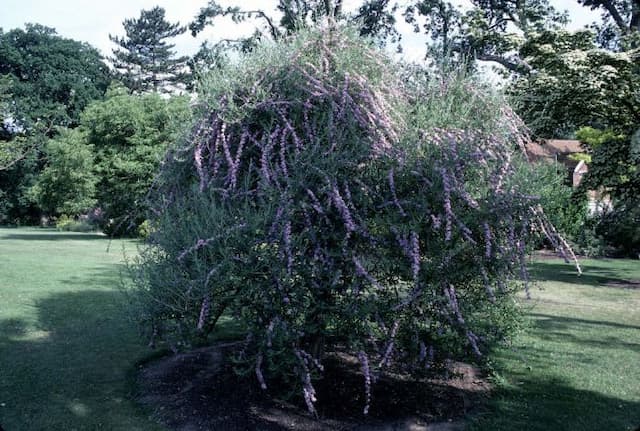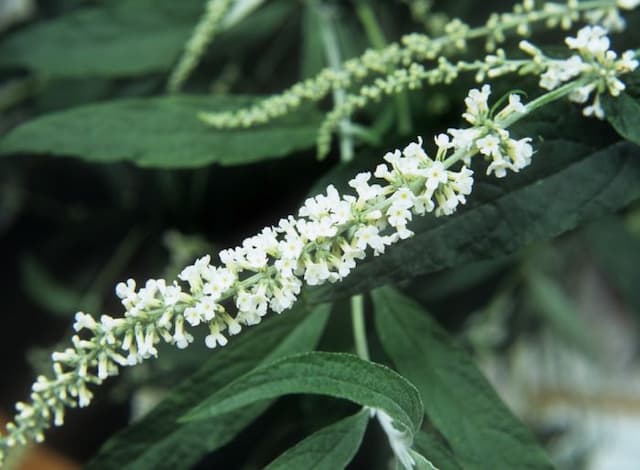Greek Mullein Verbascum epixanthinum

ABOUT
Verbascum epixanthinum, commonly known as the yellow mullein, is a distinctive plant known for its rosette of large, sturdy leaves and tall, erect flowering stems. The leaves are typically fuzzy, with a soft, velvety texture and a grayish-green color. They are often elongated and can have a slightly wavy or curled edge. Rising from the center of the leaf rosette is the flower spike, which displays an array of bright yellow flowers. These flowers are usually arranged in a dense, spike-like cluster along the stem. Each flower typically has five rounded petals that surround the prominent stamens, which often have violet or purple filaments topped with orange anther, lending an eye-catching contrast against the yellow petals. The overall form of the plant is characterized by these large basal leaves and one or more flower spikes, which give it a striking and easily recognizable silhouette in its natural habitat.
About this plant
 Names
NamesSynonyms
Banana Mullein, Yellow Mullein
Common names
Verbascum epixanthinum
 Toxicity
ToxicityTo humans
Verbascum epixanthinum, commonly known as mullein, is not widely regarded as a toxic plant to humans. However, like many plants, it can potentially cause mild irritation to some individuals, especially if they have specific allergies or sensitivities. Typically, mullein is used in herbal medicine, and there are no well-documented cases of poisoning from the plant when used appropriately. Ingestion of any part of the plant is unlikely to cause more than mild gastrointestinal upset unless consumed in large quantities. If experiencing severe symptoms after contact or ingestion, seek medical attention.
To pets
Verbascum epixanthinum, also known as mullein, is not typically toxic to pets. However, individual animals can react differently to various plants. Ingesting mullein may cause mild digestive upset in some pets, such as vomiting or diarrhea, particularly if they consume a large amount. If you suspect your pet has ingested a significant amount of mullein and is showing signs of distress, consult with a veterinarian.
 Characteristics
CharacteristicsLife cycle
Biennials
Foliage type
Deciduous
Color of leaves
Green
Flower color
Yellow
Height
2 feet [60 cm]
Spread
1 foot [30 cm]
Plant type
Herb
Hardiness zones
5
Native area
Greece
Benefits
 General Benefits
General Benefits- Attracts Pollinators: Verbascum epixanthinum is known to attract bees and other pollinating insects, which is beneficial for the garden ecosystem.
- Ornamental Value: With its spike of yellow flowers, it adds aesthetic appeal to gardens and landscapes.
- Drought Resistance: This plant is well adapted to dry conditions, making it suitable for xeriscaping and low-water gardens.
- Erosion Control: Its root system helps stabilize soil and prevent erosion on slopes or in areas with loose soil.
- Habitat for Wildlife: Provides shelter and food for certain insects, thus contributing to biodiversity.
- Low Maintenance: Requires minimal care once established, making it a good choice for gardeners seeking low-effort plants.
 Medical Properties
Medical Properties- Anti-inflammatory: Verbascum epixanthinum may possess anti-inflammatory properties useful in reducing inflammation.
- Antibacterial: The plant has potential antibacterial effects, which might help in fighting bacterial infections.
- Antitussive: It might be used to relieve coughs due to its possible antitussive effects.
- Demulcent: Verbascum epixanthinum could have a soothing effect on irritated mucous membranes.
- Emollient: The plant may act as an emollient, helping to soften and protect the skin.
- Expectorant: It might serve as an expectorant by helping to clear mucus from the airways.
 Air-purifying Qualities
Air-purifying QualitiesThis plant is not specifically known for air purifying qualities.
 Other Uses
Other Uses- Natural Dye: Verbascum epixanthinum can be used to produce a natural dye for coloring fabrics and yarns. The flowers are particularly useful in yielding yellow to greenish hues.
- Insect Repellent: The plant's natural compounds can deter insects, making it a practical choice for planting in gardens to keep certain pests away.
- Livestock Feed: While not a prime choice for fodder, the leaves of the plant can be consumed by livestock if other food sources are scarce.
- Biodegradable Mulch: Dried and shredded leaves and stems of Verbascum epixanthinum can serve as a biodegradable mulch that enriches the soil as it decomposes.
- Illumination: The dried stalks, being fibrous and flammable, were historically used for torches before the advent of modern lighting.
- Ecological Indicator: The presence of Verbascum epixanthinum in the wild can be an indicator of certain soil conditions, such as lime content.
- Photography: The soft, felt-like texture of the leaves, and bold flowers provide interesting textures and subjects for macro and nature photography.
- Fish Poison: Historical records suggest that some Verbascum species were used to stupefy fish, making them easier to catch, although this is not an environmentally friendly or legal practice today.
- Craft Material: Dried Verbascum flowers and stems can be used in floral arrangements, wreaths, or other crafts for their aesthetic appeal.
- Soil Erosion Control: Verbascum epixanthinum, with its robust root system, can be planted to help stabilize soil and prevent erosion on slopes or in areas prone to degradation.
Interesting Facts
 Feng Shui
Feng ShuiThe plant Verbascum epixanthinum, commonly known as Mullein, is not used in Feng Shui practice.
 Zodiac Sign Compitability
Zodiac Sign CompitabilityMullein is not used in astrology practice.
 Plant Symbolism
Plant Symbolism- Healing: Verbascum, commonly known as Mullein, has been historically used for its medicinal properties, particularly in treating respiratory ailments. It thus symbolizes health and healing.
- Protection: Mullein is often associated with warding off evil and negativity, as it was believed to dispel demons and nightmares when used in ancient rituals.
- Love Divination: In some folk traditions, Mullein has been used as a tool in love divinations, perhaps due to its soft and attractive flowers.
- Courage: The sturdy stalk of Mullein can be seen as a symbol of resilience and courage, standing tall and firm against the elements.
- Purification: Mullein is sometimes linked with purity and cleansing, likely due to its use in herbal teas that were thought to purify the body and spirit.
 Water
WaterThe Banana Custard Mullein (Verbascum epixanthinum) should be watered deeply but infrequently, allowing the soil to dry out between waterings. Aim to water approximately once a week during active growth in the spring and summer, depending on weather conditions. Reduce watering frequency in the fall and further in the winter when the plant is dormant. When you water, use enough water to soak the root zone, which might equate to around 1-2 gallons for an established plant in open soil, varying with the size of the plant and the environmental conditions.
 Light
LightBanana Custard Mullein thrives in full sun, meaning it requires at least six hours of direct sunlight daily. It is best placed in a spot where it can receive unobstructed sunlight throughout the day. This plant will perform well if it gets morning light that transitions into bright afternoon sun, making a south-facing garden location ideal for its growth.
 Temperature
TemperatureBanana Custard Mullein prefers temperate conditions and can tolerate temperatures ranging from around 40°F to 80°F. It's hardy to USDA zones 5 through 9, indicating it can survive winter lows down to -20°F once established. The ideal temperature for this plant is within the range of 60°F to 70°F, which promotes healthy growth during its active season.
 Pruning
PruningPruning the Banana Custard Mullein is essential to remove spent flower spikes and encourage further blooming. Deadhead the flower stalks once they have faded, typically after the summer bloom. If desired, cut back the foliage in late fall to tidy the plant. The best time for substantial pruning is early spring before new growth begins.
 Cleaning
CleaningAs needed
 Soil
SoilGolden mullein (Verbascum epixanthinum) thrives in a well-draining soil mix with sandy or rocky texture, preferably with some organic matter. The ideal pH for this plant is slightly alkaline, ranging from 6.8 to 7.5. A mix of two parts sand, one part loam, and one part compost or peat would work well for golden mullein.
 Repotting
RepottingGolden mullein does not often require repotting as it is a biennial plant. It typically spends the first year developing a rosette of leaves and blooms in the second year. After flowering, the plant may die back, so repotting is generally unnecessary unless grown as a perennial in favorable conditions.
 Humidity & Misting
Humidity & MistingGolden mullein prefers drier conditions and is tolerant of low humidity levels common in temperate climates. It does not thrive in high humidity environments and excessive moisture should be avoided to prevent issues such as root rot or fungal diseases.
 Suitable locations
Suitable locationsIndoor
Place in bright light, minimal water, well-draining soil mix.
Outdoor
Full sun, well-drained soil, water sparingly, protect from excess moisture.
Hardiness zone
5-9 USDA
 Life cycle
Life cycleVerbascum epixanthinum, commonly known as mullein, begins its life cycle as a seed, which requires a period of dormancy before germination, often helped by cold or fluctuating temperatures. Upon germination, the seedling emerges and grows into a rosette of basal leaves during its first year, in a stage known as the vegetative phase. In the second year, the biennial plant enters its reproductive phase, sending up a tall flowering stalk that bears yellow flowers arranged in a dense spike. After pollination, typically by bees or other insects, the flowers develop into seed capsules, which eventually release seeds back into the surrounding environment. The parent plant usually dies after seed dispersal, completing the life cycle. However, some individuals may persist or regrow from the rootstock if conditions are favorable.
 Propogation
PropogationPropogation time
Spring-Early Summer
The most popular method for propagating Verbascum epixanthinum, commonly known as Goldenrod Horehound, is through seed. Sowing seeds can be done in late winter or early spring, usually indoors to protect them from frost. Fill a seed tray with a well-draining soil mix, sprinkle the tiny seeds on top, and lightly press them into the soil; they need light to germinate, so do not cover them with soil. Keep the soil moist but not waterlogged, and place the tray in a bright area but out of direct sunlight. Seeds typically germinate within two to three weeks at room temperature, between 65 to 70 degrees Fahrenheit (18 to 21 degrees Celsius). After seedlings have developed a couple of true leaves and are strong enough, they can be transplanted into individual pots or directly outdoors after the last frost has passed.




![Butterfly bush [Florence]](/_next/image?url=https%3A%2F%2Fplants-admin.emdemapps.com%2Fimages%2Fplants%2F%2Fimages%2F604b5f52d7bb1.png&w=640&q=75)




